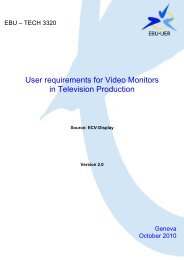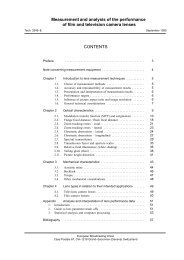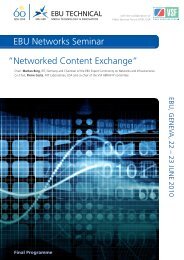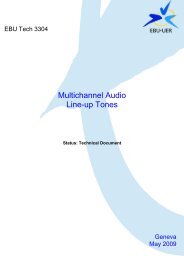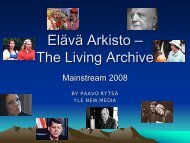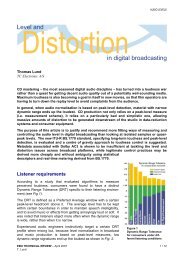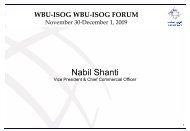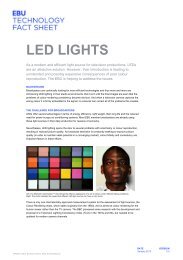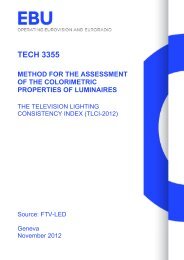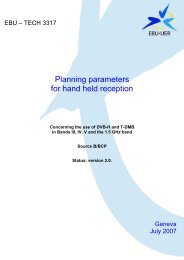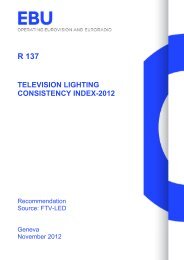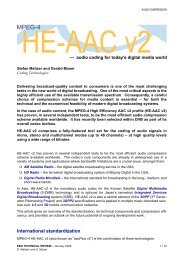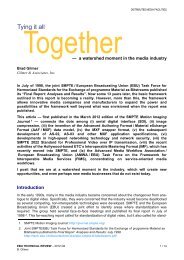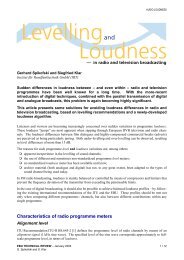Production Technology Seminar 2009 - EBU Technical
Production Technology Seminar 2009 - EBU Technical
Production Technology Seminar 2009 - EBU Technical
Create successful ePaper yourself
Turn your PDF publications into a flip-book with our unique Google optimized e-Paper software.
HFR Conclusion<br />
Increasing the static resolution without improving the frame rate makes the TV system less and less<br />
suitable for moving pictures (NHK is now considering what it should do about frame rate for<br />
Super HiVision). We assert that increasing the frame rate for capture and display of television pictures<br />
produces a very significant improvement in video quality, and increases production flexibility, especially<br />
for sports material (e.g. covering tennis from the side as well as from the end of the court becomes<br />
possible).<br />
3.4 Future Television <strong>Production</strong> – Proof of Concept<br />
Maarten Verwaest, VRT R&D Department, Belgium<br />
PISA - <strong>Production</strong>, Indexing and Search of Audiovisual Material is a 30 man-year research project of<br />
the VRT-Medialab 41 with IBBT (Interdisciplinary Research Institute) 42 , on video search technology,<br />
unsupervised feature extraction and computer-assisted production.<br />
Context of the project. In previous years we did some extensive research on file-based production in<br />
terms of networked storage and of a single file-based 'production machine' [3]. On top of that we have<br />
investigated and intalled a lot of software applications that have virtualised and integrated our production<br />
process, including Ingest, Editing, Playout [4]… However, if we look at the particular context of drama<br />
production, we actually see that the metadata flow, which sits on the top of the sytem and that<br />
associates the management information for all the media assets, is usually combined by documents [5].<br />
News are a little more advanced – and journalists will use an editorial application – but it is still<br />
unstructured text and it is difficult to manage and to automate the information flow that actually controls<br />
the production 'machine'. However we think it is crucial, that when all the material we produce is going<br />
out in digital form (via DVB-S, cable or telecoms lines) to capitalise on that metadata to be able to bring it<br />
out in a structured way, to take care of our EPG, etc. We should find the means to harvest the different<br />
sources of metadata and offer that in a nice and attractive form to the consumer [7].<br />
In order to solve that we bought a MAM system [6] and did a lot of 'plumbery' and then we could end up<br />
with an information portal on top of our News material 43 [8]. We took a look on what BBC did with<br />
iPlayer 44 and had this broadband experience of News. It is like TV experience on the first sight but it<br />
combines different ways of sorting out your news items, mark up 'My personal channels' and includes<br />
search functionalities. We have in Flanders normally 1 million news consumers per day, between<br />
100 000 an 200 000 people using the News Web site, that is 10% of our audience, and a significant part<br />
is attracted by the 'VideoZone' [8] introduced mid January <strong>2009</strong>.<br />
Users want something more than just redistribution of a single cast on different distribution channels.<br />
They expect "configurable" content, that means: scalable content served by multiple distribution<br />
channels, hybrid formats complementary using multiple distribution channels, value added applications<br />
(EPG, Favourites, MyChannel,…) relying on various metadata sources. On-line offering is characterised<br />
by personalisation.<br />
Our definition of a future television production is based on the following assessements:<br />
� Concurrent engineering (collaborative production) increases productivity.<br />
� Modular production apparatus enables a configurable product.<br />
� A Digital Supply Chain Manager should ensure overall consistency and performance. Individual Media<br />
Asset Management systems don‟t match this requirement and ad hoc plumbing (“best of breed”)<br />
compromises stability and quality of the product.<br />
41 http://medialab.vrt.be/pisa<br />
42 http://projects.ibbt.be/pisa<br />
43 http://www.deredactie.be/cm/de.redactie<br />
44 http://www.bbc.co.uk/iplayer/<br />
© <strong>EBU</strong> <strong>2009</strong> / <strong>Production</strong> <strong>Technology</strong> seminar / January 27 - 29, <strong>2009</strong><br />
Reproduction prohibited without written permission of <strong>EBU</strong> TECHNICAL & <strong>EBU</strong> TRAINING<br />
51



